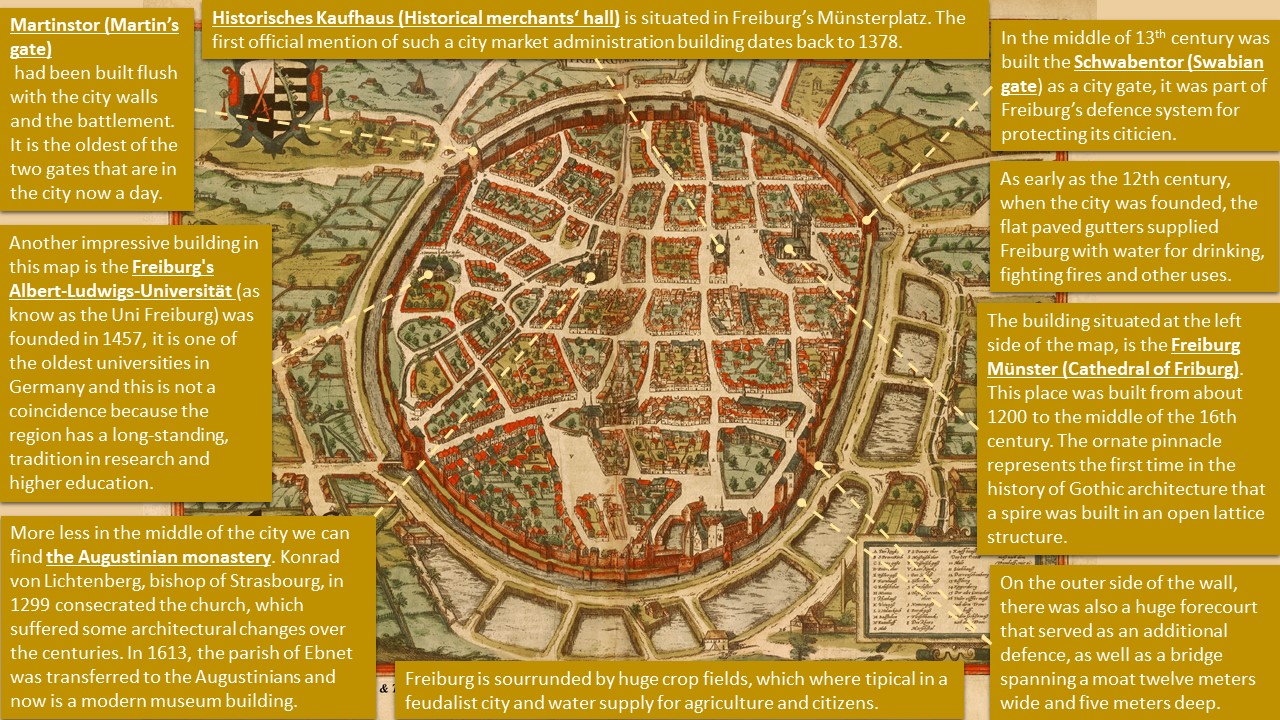The image was created by Georg Braun and Frans Hogenberg in the 16th century, more exactly in the year 1575. These authors published six volumes from 1572 to 1617, and one of their most important works is the atlas Civitates Orbis Terrarum, in which this image is included. Braun was the principal editor of the work and Hogenberg engraved the majority of those in the Civitates Orbis Terrarum and may have been responsible for originating the project.
Freiberg is a city in the state of Saxony, southeastern Germany. Regarding the morphology of the city we can see that it has a circular shape and it presents an irregular layout with narrow streets, surrounded by a battlement which city gates were where merchandise was inspected, and a customs duty applied, especially with the significant increase in trade in Freiburg in the 14th century. Concerning the buildings, this city has some singularities as the cathedral, the monastery and the University. The cathedral is located northeast of the city, almost intact it was built about 1200 and itself wasn’t completed until 1513 and the oldest of the cathedal’s bells, the Hosanna, which is still in use today, was cast in 1258. The Freiburg Münster, is the parish church and since 1821 Episcopal Church of the Archdiocese of Freiburg.
The second important monument in the city is the Augustinian monastery located at the centre of the chaos of the plane that was first mentioned in a document on 16 December 1278. The wording of the document suggests that the Augustinian Hermits had been resident in the city for some time. Thanks to the architect Christoph Mäckler, the former monastery church has been transformed into an impressive modern museum building. Another interesting building is the Freiburg’s Albert-Ludwigs-Universität, that was founded in 1457 at the northwest of the city, to be one of the oldest universities in the Austrian Empire. It is hardly a coincidence that the first University College in Germany was established in Freiburg. The region has a long-standing, tradition in research and higher education, dating back to Early Modern Humanism and notable figures such as Erasmus of Rotterdam, Johannes Gutenberg, and Martin Waldseemüller.
We must also emphasize the Münsterplatz, today one of the most important squares of the old town of the city of Freiburg. The Münsterplatz is the paved area surrounding the cathedral of Freiburg. However, it was not always a square. In the year 1514 Emperor Maximilian I ordered the creation of a cemetery in that most peripheral area for reasons of health and hygiene. Since its definitive cessation as Münster Cemetery, a market is being held on Münsterplatz, moving from its traditional place since the Middle Ages, the «Great Grass», now known as Kaiser-Joseph-Straße. The market takes place every morning on Monday and Friday. At approximately 10,000 square meters, with 180 market stalls offer food, crafts and souvenirs. Until the creation of the pedestrian area of Freiburg in the 1970s, the square was used as parking in the afternoon.
Outside of the walls of the city, there is the moat twelve meters wide and five meters deep to reinforce the defense. As well that surrounding the city, we found some houses, one could say that they set up the «suburbs» and we can assume that these are the houses of the peasants who care for the crop fields for the support of its habitants and intended for trade. The European Middle Ages begins to be a level of an agricultural society, which is the basis of its economy and its subsequent development. In addition, in the image there are some water reserves probably for the supply of the crop fields and for its citizens, on the other hand we don’t appreciate animals, it could be said that the main source of its economy is agriculture and as we said before the commercial activity.
Nowaday, Freiberg is completely renovated and is one of the cities within the cluster «green city» project. The city is one of the founders of the environmental movement. Freiburg conducted a campaign against the Wyhl nuclear power plant 30 years ago and was followed by the creation of the Environmental Protection Office in 1986. These events were the ones that impelled the citizens to start using projects and concepts of ecological models to become a sustainable city. This is the reason why Freiburg has become a model for others, investors and tourists from around the world who have heard about the Green City.
Raquel Rodríguez Loarce

